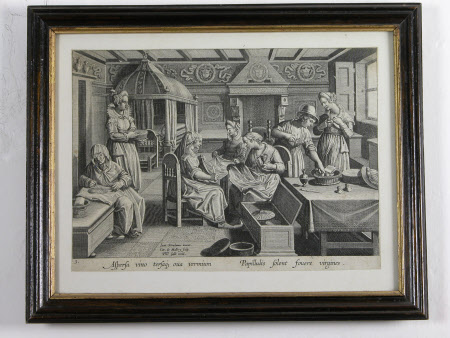Vermis sericus - The incubation of the silkworm eggs (after Jan van der Straet,called Stradanus)
Philip Galle (Haarlem 1537 - Antwerp 1612)
Category
Art / Prints
Date
1523 - 1605
Materials
Paper, Wood
Measurements
203 x 267 mm
Order this imageCollection
Lindisfarne Castle, Northumberland
NT 511837
Summary
Print, engraving, Vermis sericus - The incubation of the silkworm eggs (after Jan van der Straet,called Stradanus) by Philip Galle (Haarlem 1537 - Antwerp 1612)One of a set of six early engravings (LIN/P/56 to 61) of silk worm farming and silk weaving in 16th century Florentine houses. The prints depict silk worm farming and preparation of the looms for weaving. They were engraved by Philip Galle (1537 - 1612) after the originals by Jan van der Straet (1523 -1605). In moulded frames. This engraving shows the incubation of the silkworm eggs, a process more delicate than the later raising of the silkworms, so it is often done indoors under controlled conditions. The eggs were laid on sheets of fabric or paper, and women often placed them between their breasts to warm them, as can be seen in the right of the picture where the woman is clutching the closure of her bodice. The little bundles on the table are probably full of silkworm eggs, and the baskets in the picture are used to carry them from place to place.
Makers and roles
Philip Galle (Haarlem 1537 - Antwerp 1612), engraver (printmaker) Jan van der Straet, called Stradanus (Bruges 1523 - Florence 1605), publisher
